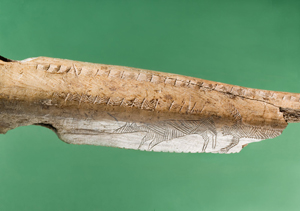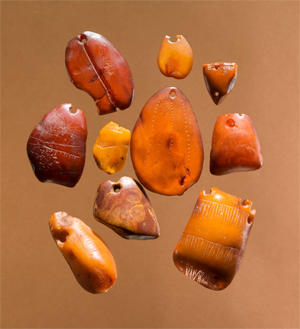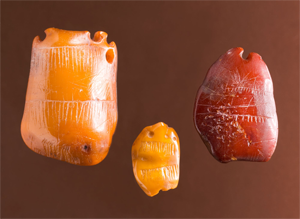
Overall, engravings on Mesolithic pendants are extremely rare, with the exception of amber pendants found in southern Scandinavia (Płonka 2003). Art has also been found on a number of other types of portable artefacts made from a range of materials including bone, flint, antler and wood, and the centre for this art can be argued to be Denmark owing to the sheer quantity of examples that have been found there; other pieces have also been found in Sweden, Germany, Poland, Russia, Estonia, France, Belgium, Spain and Britain (Płonka 2003). It is unclear exactly how many pieces exist, but Nash (1998, 2) suggested that at least 400 antler and bone artefacts with art inscribed on them originate from Denmark.

A stray find in 1950 from Bodal Mose, in the Åmose on the island of Zealand, Denmark, is an example of an elaborately decorated piece of antler (Andersen 2001; Brinch Petersen 1982). Its surface had been smoothed and was decorated with geometric motifs of an animal and the outline of what has been interpreted as a human being (Figure 32), a sleeping shaman or a shaman in a trance, possibly used in connection with a hunting ritual. The human and animal are covered by parallel incised lines, which may represent skins (Andersen 2001).

In terms of pendants, a total of 73 decorated amber pendants have been found in Denmark, Skania in Sweden and Holstein in northern Germany (Toft and Brinch Petersen 2016) (see Figures 33 and 34 for examples). Of these, the majority are stray finds (e.g. Fischer and Vang Petersen forthcoming; Nielsen 1982) and only seven are derived from in situ contexts: five from Zealand and one each from Jutland and northern Germany (Andersen 1998; Andersen et al. 1982; Fischer and Vang Petersen forthcoming; Hartz 1998; Henriksen 1980; Toft and Brinch Petersen 2016; Vang Petersen 2016). Although these pendants have been made from amber, antler and bone have also been used (Andersen 2001; Gramsch 2014). The pendants are perforated and often polished, which may have resulted from preparation before decoration, handling and use in antiquity (Andersen 2001) or water rolling (Vang Petersen 2016). Some also have faint grooves present (Andersen 2001; Vang Petersen 2016) which researchers have argued indicates that these objects were attached to a cord and worn around the neck as pendants or amulets (e.g. Clark 1936; Gramsch 2014; Toft and Brinch Petersen 2016; Vang Petersen 2016), although this conjecture is far from certain.

A range of markings were produced using three techniques: boring, carving and incision (Clark 1936). These techniques have been observed on objects from sites dated throughout the Mesolithic in Denmark: from the Maglemose (Early Mesolithic), the Kongemose (Middle Mesolithic) and Ertebølle (Late Mesolithic). Markings include variations on lines and barbed lines, chevrons, net patterns, chequer patterns, lozenges, variations of cross-hatched lines, and hachured triangles (Clark 1936; Nash 1998).